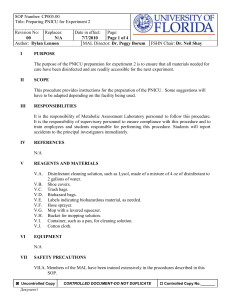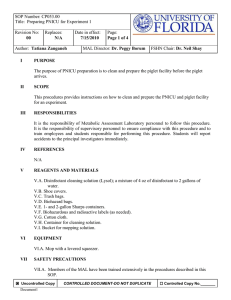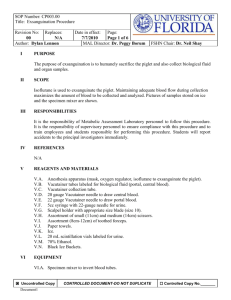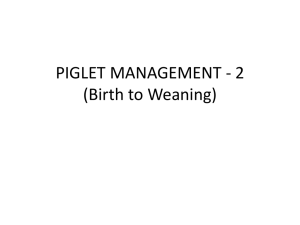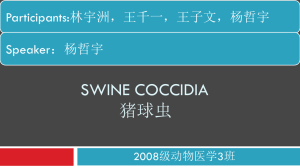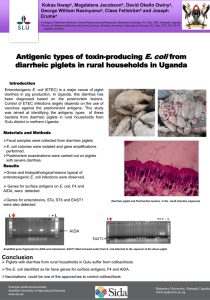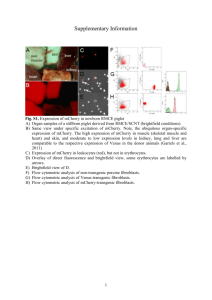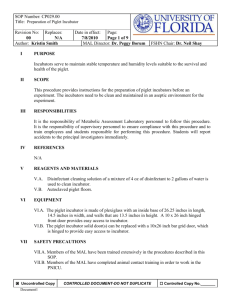Administration of Anesthesia Procedure
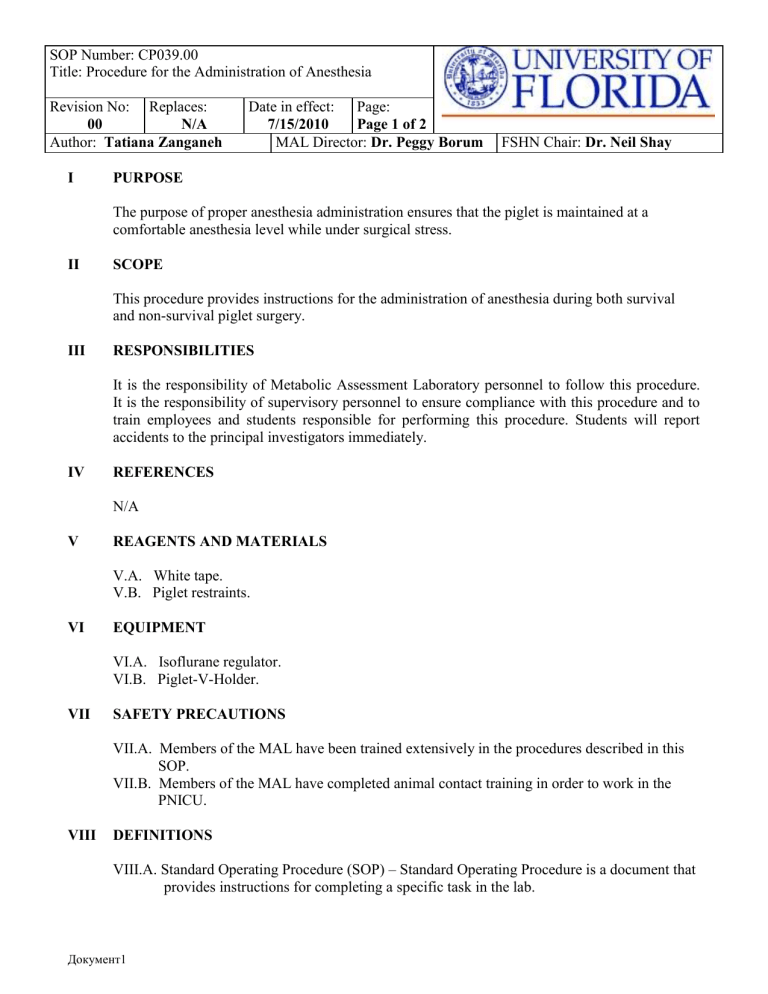
SOP Number: CP039.00
Title: Procedure for the Administration of Anesthesia
Revision No:
00
Replaces:
N/A
Author: Tatiana Zanganeh
Date in effect:
7/15/2010
Page:
Page 1 of 2
MAL Director: Dr. Peggy Borum FSHN Chair: Dr. Neil Shay
I PURPOSE
The purpose of proper anesthesia administration ensures that the piglet is maintained at a comfortable anesthesia level while under surgical stress.
II SCOPE
This procedure provides instructions for the administration of anesthesia during both survival and non-survival piglet surgery.
III RESPONSIBILITIES
It is the responsibility of Metabolic Assessment Laboratory personnel to follow this procedure.
It is the responsibility of supervisory personnel to ensure compliance with this procedure and to train employees and students responsible for performing this procedure. Students will report accidents to the principal investigators immediately.
IV REFERENCES
N/A
V REAGENTS AND MATERIALS
V.A. White tape.
V.B. Piglet restraints.
VI EQUIPMENT
VI.A. Isoflurane regulator.
VI.B. Piglet-V-Holder.
VII SAFETY PRECAUTIONS
VII.A. Members of the MAL have been trained extensively in the procedures described in this
SOP.
VII.B. Members of the MAL have completed animal contact training in order to work in the
PNICU.
VIII DEFINITIONS
VIII.A. Standard Operating Procedure (SOP) – Standard Operating Procedure is a document that provides instructions for completing a specific task in the lab.
Документ1
SOP Number: CP039.00
Title: Procedure for the Administration of Anesthesia
Revision No:
00
Replaces:
N/A
Date in effect:
7/15/2010
Page:
Page 2 of 3
VIII.B. Metabolic Assessment Laboratory (MAL) – The Metabolic Assessment Laboratory is the laboratory that will use this SOP.
VIII.C.
Piglet Restraints – Thin strips of cloth material used to tie the piglet’s limbs down and away from the surgeon.
VIII.D. Piglet V-Holder—The Piglet V-Holder is a metal basin that is V-shaped and supports piglet’s body during surgery.
VIII.E. Piglet Neonatal Intensive Care Unit (PNICU) – The PNICU is a unit where the piglet is monitored by 24 hour care and routine check-up parameters using PNICU SOPs conducted by the MAL.
IX PROCEDURE
IX.A. General Procedure of isoflurane administration
IX.A.1. The member acting as the anesthesiologist turns on the oxygen regulator, first.
IX.A.1.a. The anesthesiologist turns the oxygen regulator to level 5.
IX.A.2. The surgeon holds the piglet and places the mask over the piglet’s snout.
IX.A.3. The anesthesiologist turns the isoflurane regulator to 5 (Turning on the isoflurane regulator before it is placed on the piglet’s snout will result in leakage of isoflurane into the surgery room space)
IX.A.3.a. Make sure the mask is held firmly onto the piglet’s face.
IX.A.3.b. Press the white tab down while turning the regulator to 5.
IX.A.4. The surgeon continues to hold the piglet until the piglet is fully anesthetized.
IX.A.4.a. It may take longer than expected to anesthetize a larger piglet.
IX.A.5. The anesthesiologist turns the isoflurane control to a maintenance level of 1-2 and follows the surgeon’s directions for the isoflurane regulator level throughout the course of the surgery. The isoflurane regulator level may be adjusted at the anesthesiologist’s discretion.
IX.A.6. The surgeon places the piglet down onto the Piglet V-Holder and secures the piglet by tying and fastening piglet restraints to the piglet.
IX.A.7. Pinch the piglet with toothed forceps to ensure the piglet has been anesthetized.
IX.B. Procedure of isoflurane administration in survival surgery
IX.B.1. All who are present in the surgery room should pay close attention to piglet’s breathing and color throughout surgery, especially the anesthesiologist.
IX.B.1.a. If the piglet’s snout or skin color becomes pale (usually light purple or white), turn the isoflurane regulator down.
IX.B.1.b. It is imperative that the piglet is carefully monitored following this change to prevent the piglet’s awakening. If the piglet’s heart rate or respiration increases, the anesthesiologist should raise the isoflurane level accordingly.
IX.B.1.c. As the last incision is finished being sewn up, slowly turn the isoflurane to zero, but leave the oxygen regulator on while the mask is still on the piglet. Leave the oxygen on until the piglet awakes and the surgeons deems it appropriate to turn off the oxygen.
Документ1
SOP Number: CP039.00
Title: Procedure for the Administration of Anesthesia
Revision No:
00
X
Replaces:
N/A
ATTACHMENTS
Date in effect:
7/15/2010
Page:
Page 3 of 3
X.A. For a list of materials and their locations, refer to SOP# CG098.00.
Документ1
